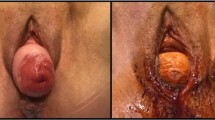Abstract
Background
Gynecare Prolift has been successfully used for pelvic floor repair with favorable objective and subjective outcomes. There have been, however, increasing reports of significant rates of postoperative dyspareunia and impairment of sexual function.
Materials and methods
We are presenting two cases of post Prolift dyspareunia. The patients underwent several vaginal revisions with excision of the apical bands. However, they returned soon with the same complaint. Ultimately, laparoscopic excision of the apical mesh was performed.
Results
Patients reported significant improvement in their intercourse pain after the procedure.
Conclusion
Our experience shows that new onset dyspareunia is primarily caused by the apical component of the Prolift system with deep penetration pain reproduced by pressure on the fixed nondistensible apex. This problem can be treated laparoscopically with excision of the apical mesh.

Similar content being viewed by others
References
Weng SS, Liu CY (2008) Laparoscopic pelvic floor repair using polypropylene mesh. Taiwan J Obstet Gynecol 47(3):312–317. doi:10.1016/S1028-4559(08)60130-8
Ridgeway B, Walters MD, R Paraiso MF, Barber MD, McAchran SE, Goldman HB, Jelovsek JE (2008) Early experience with mesh excision for adverse outcomes after transvaginal mesh placement using prolapse kits. Am J Obstet Gynecol, 7 October [Epub ahead of print]
Lowman JK, Jones LA, Woodman PJ, Hale DS (2008) Does the Prolift system cause dyspareunia? Am J Obstet Gynecol, 31 October [Epub ahead of print]
Hinoul P, Ombelet WU, Burger MP, Roovers JP (2008) A prospective study to evaluate the anatomic and functional outcome of a transobturator mesh kit (prolift anterior) for symptomatic cystocele repair. J Minim Invasive Gynecol 15(5):615–620. doi:10.1016/j.jmig.2008.05.009
Weber AM, Walters MD, Piedmonte MR (2000) Sexual function and vaginal anatomy in women before and after surgery for pelvic organ prolapse and urinary incontinence. Am J Obstet Gynecol 182(6):1610–1615. doi:10.1067/mob.2000.107436
Gauruder-Burmester A, Koutouzidou P, Tunn R (2008) Effect of vaginal polypropylene mesh implants on sexual function. Eur J Obstet Gynecol Reprod Biol, 1 November [Epub ahead of print]
Nieminen K, Hiltunen R, Heiskanen E, Takala T, Niemi K, Merikari M, Heinonen PK (2008) Symptom resolution and sexual function after anterior vaginal wall repair with or without polypropylene mesh. Int Urogynecol J Pelvic Floor Dysfunct 19(12):1611–1616. doi:10.1007/s00192-008-0707-7
Sarlos D, Brandner S, Kots L, Gygax N, Schaer G (2008) Laparoscopic sacrocolpopexy for uterine and post-hysterectomy prolapse: anatomical results, quality of life and perioperative outcome-a prospective study with 101 cases. Int Urogynecol J Pelvic Floor Dysfunct 19(10):1415–1422. doi:10.1007/s00192-008-0657-0
Conflict of interest statement
None of the authors has any potential conflict of interest.
Author information
Authors and Affiliations
Corresponding author
Rights and permissions
About this article
Cite this article
Walid, M.S., Heaton, R.L. Laparoscopic apical mesh excision for deep dyspareunia caused by mesh banding in the vaginal apex. Arch Gynecol Obstet 280, 347–350 (2009). https://doi.org/10.1007/s00404-008-0911-1
Received:
Accepted:
Published:
Issue Date:
DOI: https://doi.org/10.1007/s00404-008-0911-1



